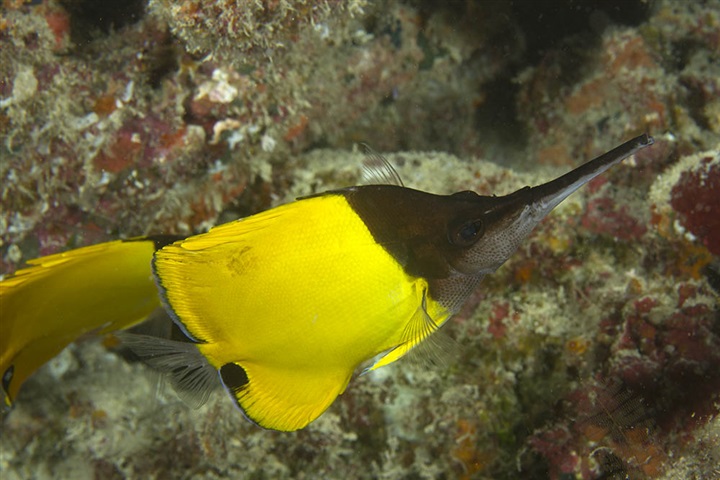Forcipiger longirostris

| Latin name | Forcipiger longirostris - (Broussonet, 1782) |
|---|---|
| Local name | Longnose butterflyfish |
| Family | Chaetodontidae - Forcipiger |
| Origin | East Indian Ocean, West Indian Ocean, Australia, The Red Sea, Indonesia, East Pacific, Central/West Pacific |
| Max length | 22 cm (8.7") |
| Minimum volume |
400 l (106 gal) |
|---|---|
| Hardiness |
Average |
| Suitable for aquarium |
Experience, preparation and extra care required |
| Reef safe |
Always reef safe |
| Aggressiveness | Mostly peaceful but might be aggressive towards similar species |
| Recommended |
Small crustaceans (Krill, mysis, artemia...) Zooplankton (Cyclops, pods...) |
|---|
This species likes to eat tubeworms.
This species must be fed with an appropriately varied diet.
This species thrives best when there is a sufficiently large amount of micro life (copepods, amphipods or similar) in the aquarium, so that the it can always find their own food.
This fish requires feeding several times a day, especially when newly added.
When the fish can find its natural food in the aquarium it requires less frequent feeding.
These fish eat exceptionally slowly and can be very selective feeders.
It can therefore be problematic to provide it with a sufficient and varied diet, in an aquarium with other, faster feeding species.
This species needs good hiding places, for example, between live rocks.
This species can be very shy when first introduced into a new aquarium.
More aggressive fish can be introduced after this species has acclimatized.
This species can be distinguished from F. flavissimus by the all dark eye and the longer snout.
It needs to be feed very small pieces of food.
There is also an all brown variant of this species.
The Butterflyfish are known for their attractive patterns and colours. They are closely related to Angelfishs, but can always be distinguished, as they lack the spines on each side of the head of the Angelfish.
A smaller group of these fish will seek out primairily soft corals, like Zoanthus. A larger part of the species will target different types of LPS corals. Butterflyfish are also known to seek out anemones, tubeworms and bristleworms.
Therefore it is important to choose the correct species in relation to the corals wanted, if one desires to keep Butterflyfish in a coral-aquarium.
Bristleworms, tubeworms and other small invertebrates are also a part of the diet for many Butterflyfish.
It can be problematic, with many of these species, to get them eating in the beginning, but many of the species cannot resist live zooplankton or live mussels with crushed shells. Another option is to mimic their natural behaviour by stuffing their food into coral skeletons or stones.
They ignore most other fish and are generally peaceful, therefore multiple Butterflyfish will have no problem living together. One should however be cautious about keeping similar species together unless they are a couple.
As these fish can be difficult to acclimatize and get feeding, it is important to buy healthy fish, to avoid having to deal with more problems. Make sure to check that they do not have parasites or any visible infections.
There are some species that should not be kept in an a aquarium, as they are food specialists and will almost always refuse to eat replacement foods. It can be possible to breed some species, which will eat frozen foods. Otherwise the only way to keep food specialists is by feeding them their natural diet, which consists of live SPS or LPS corals for example.
| Aquarium trade | Yes |
|---|---|
| Distribution | Indo-Pacific: East Africa to the Hawaiian, Marquesan, and Pitcairn islands, north to the Bonin [=Ogasawara] Islands, south to New Caledonia and the Austral Islands; throughout Micronesia. |
| German common names |
Langschnäuziger Pinzettfisch |
| English common names |
Longsnouted coralfish Big long-nosed butterflyfish Big longnosed butterflyfish Rare long-nose |
| Danish common names |
Langsnudet pincetfisk |
| French common names |
Poisson pincette à très long nez |
Bob Fenner. The Yellow Longnose Butterflyfishes, Genus Forcipiger - Wet Web Media - (English)
Scott W. Michael. 2004. Angelfishes and Butterflyfishes (Reef Fishes Series Book 3) TFH Publications / Microcosm Ltd. - (English)
Bob Fenner. Butterflyfishes; Separating the Good Ones and Those You Don't Want - Wet Web Media - (English)
Collection of links to additional information - Wet Web Media - (English)
Tea Yi Kai. 2014. Reef Nuggets 2: Aquatic Lepidopterans for your reef (Revised edition) - Reef Builders - (English)

